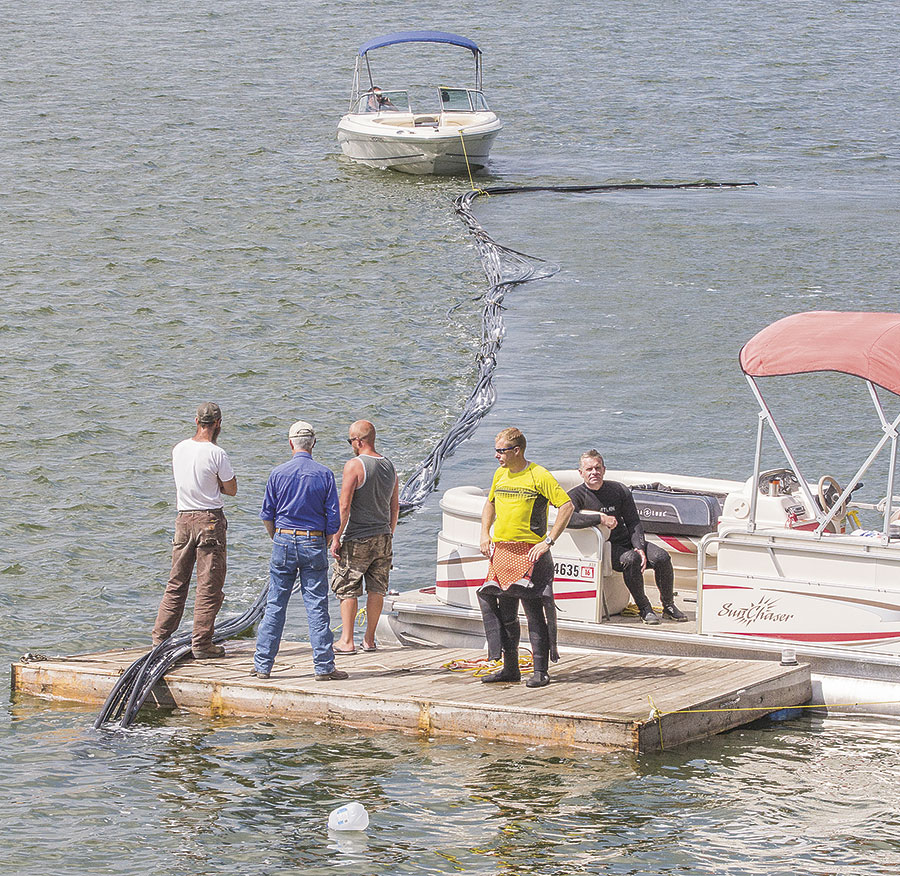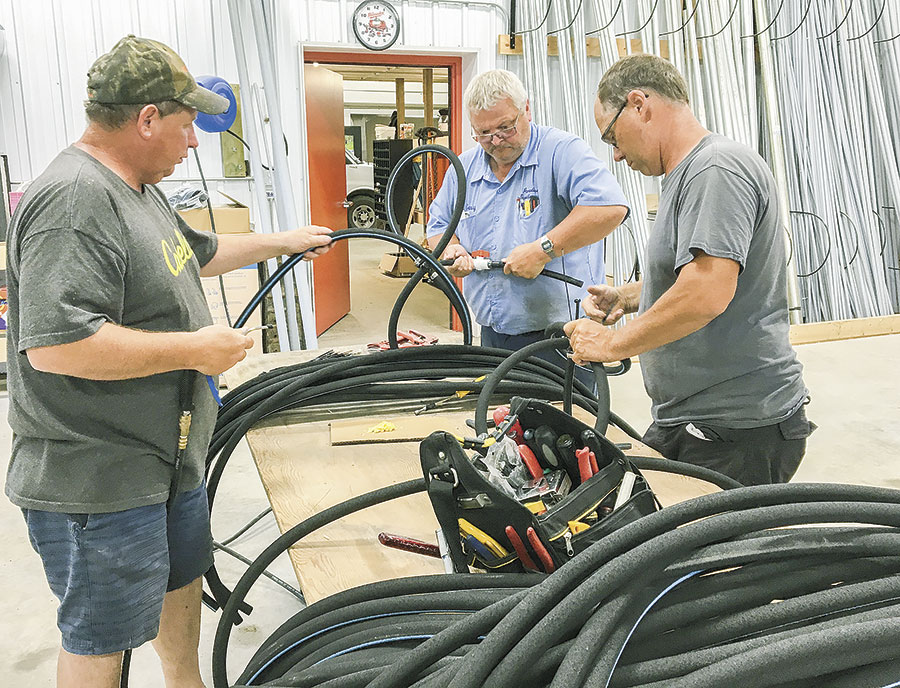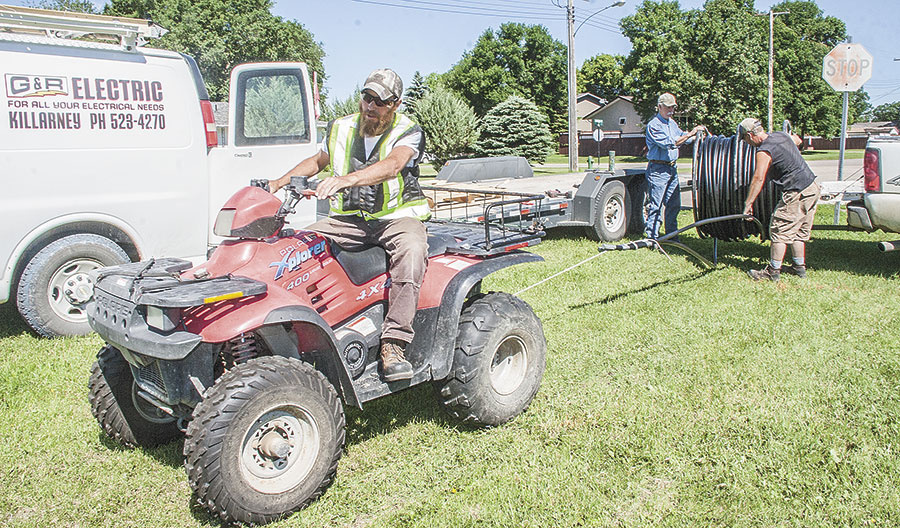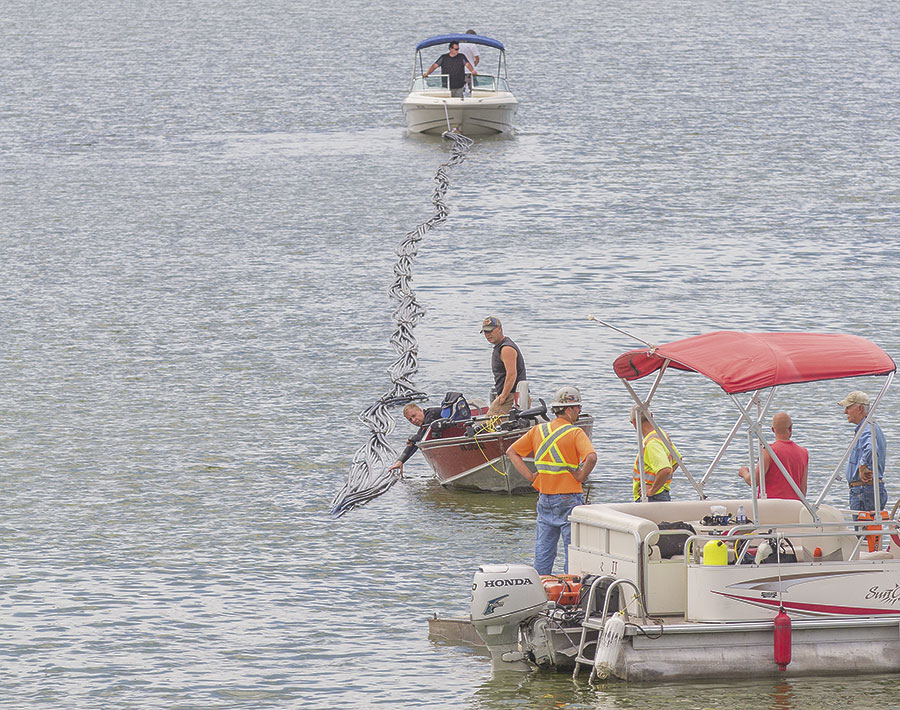
BY KIM LANGEN
After striking rubble trouble last week, a second attempt to lay the underground lake aeration lines this week resulted in triumphant success.
The team was back on site near the water treatment plant on Young Street on Monday morning, June 25, to try drilling and reaming a new line.
“The drill head has already gone out, around 220 feet out into the lake,” said Miguel Boulet, a Pugh’s Sand and Gravel employee, who was watching the progress on the water from the plant grounds. “We snagged on the bank last week. Today we are drilling a whole new hole, and we are using more mix to make it run easier and leave better walls.”
But windy weather made the lake surface choppy, and it took some time for the team out on the boats to determine just where the drill head had broken through below them.
On shore, the Pugh’s guys ran air through a compressor and down the line, in an effort to send bubbles up to the surface as a location pointer.
Eventually, scuba diver Brad Heide was able to descend and find the elusive drill head, some 20 murky feet below, tie a rope to it, and then bring the rope to the surface.
Then, three men on the boat above pulled long and hard on the rope to bring up the drill head, and to change it over to a new reamer.
“It’s very hard work to bring it up,” said Boulet. “It’s incredibly heavy. And this time we will run the reamer back and forth in the line a few times before we attach the aeration lines.”
On Tuesday, a reduced number of 10 aeration lines, made of geothermal piping, were attached to the reamer, which had been retrieved from the lake bottom by Heide and fellow diver Sean Phillips.
And then the nerve-wracking job of pulling the lines down from the lake surface, through the new channel, and back to the shore point, began.
“They were able to prep the hole, and have it in good shape,” said Clarence Sawatzky, member of the Killarney Lake Action Committee (KLAC), which is organizing the Lake Aeration Project. “And everything went well this morning. It was an easy pull.”
By Tuesday evening, volunteers had gathered together to create some 58 bubbler heads, which will eventually be attached to the 10 geothermal lines, laid out in a fan shape on the lake bottom.
The new compressor shed will soon be placed over the lines up by the water treatment plant, and eventually the compressor, plus the plumbing and the electrical components, will all be installed in the shed.
When it’s all completed sometime this summer, the compressor will force air down through the underground lines and out to the lake bottom.
Each of those lines will then send fresh air out through the multiple bubbler heads that will be attached to them.
Little bubbles will then percolate gently out of the bubbler heads, passing through the lake bottom detritus, and adding oxygen as they rise to the surface.
And then, the KLAC is hopeful Killarney Lake will slowly blossom and improve.
 AERATION LINES ON THE MOVE – Killarney Lake Aeration Project volunteers (from left) Nick Shackel, Randy Hodge, and Andrew DeCock, along with divers Sean Phillips and Brad Heide, watch on Tuesday as 10 new aeration lines begin to be pulled into a reamed channel running under the lake bed. The lines were successfully received at the water plant end of their journey – and the task declared a success.
AERATION LINES ON THE MOVE – Killarney Lake Aeration Project volunteers (from left) Nick Shackel, Randy Hodge, and Andrew DeCock, along with divers Sean Phillips and Brad Heide, watch on Tuesday as 10 new aeration lines begin to be pulled into a reamed channel running under the lake bed. The lines were successfully received at the water plant end of their journey – and the task declared a success.
JAY STRUTH/KILLARNEY GUIDE
 FASHIONING 58 FIGURE EIGHTS – Killarney Lake aeration volunteers got together on Tuesday evening at the G&R Electric shop to cut and wind around 58 figure-eight-shaped bubbler heads. Made of a porous membrane, they will eventually be attached to the aeration lines in Killarney Lake at the end of July. From left are: Dale Ganske of G&R Electric, Gerry Paradis of Paradise Geothermal, and Clarence Sawatzky of the Killarney Lake Action Committee. Below is the story from the June 22 edition of The Guide.
FASHIONING 58 FIGURE EIGHTS – Killarney Lake aeration volunteers got together on Tuesday evening at the G&R Electric shop to cut and wind around 58 figure-eight-shaped bubbler heads. Made of a porous membrane, they will eventually be attached to the aeration lines in Killarney Lake at the end of July. From left are: Dale Ganske of G&R Electric, Gerry Paradis of Paradise Geothermal, and Clarence Sawatzky of the Killarney Lake Action Committee. Below is the story from the June 22 edition of The Guide.
BETTY SAWATZKY/PHOTO
Lake aeration project snagged by rubble trouble
BY KIM LANGEN
JUNE 22 – Efforts to bore an underground channel – one that would carry 12 underground air supply lines for the local lake aeration project – came to a jolting and devastating halt on Wednesday afternoon.
It appears that an old section of cement and rebar, hidden somewhere beneath the Killarney Lake shoreline, and which was in the path of the drilling reamer, somehow snagged up both the lines and the drilling equipment.
That’s when the whole process became a snarled mess.
“It happens, when you are dealing with some variables, and doing something you have never done before,” said Clarence Sawatzky, member of the Killarney Lake Action Committee, who had been working for two days to prepare the lines and then see them fed through the drilled channel.
“It was pretty hard on everybody. Not just the cost, but also after a day of intensive labour for at least a dozen volunteers.”
Work had begun on Monday, when volunteers set up on the grass next to the water treatment plant on Young Street, with coils of black piping and a special hand cutter.
There, in hot sunshine, they cut and laid out 12 lengths of 360-foot-long sections of plastic geothermal pipeline, stretched out side-by-side in the grass, and curving up through the leafy hillside.
Above them, and behind the treatment plant itself, a team from Pugh’s Sand and Gravel were set up next to the lake, operating a Ditch Witch directional drill to create the underground channel for these one-inch diameter lines.
The first step for Pugh’s employees was to run the drill underground, creating a four-inch pilot hole, which would run out to a location some 200 feet from the shore.
It would travel about 19 feet under the lake bottom, and be directed, using locators, to a spot on the lake surface marked by a floating milk jug.
There, divers would descend the following day, to retrieve the drill head as it rose from below the lake.
Then they would exchange the small drill head with a much larger, 12-inch reamer head, for the return journey back to the shore, and the treatment plant.
But before it did, those 12 lines of piping, each now wrapped with duct tape at each end to keep the water out and make them float, would have been bundled together to make one very, very long, thick strand.
And this strand would then be attached to the reamer, and drawn along the hole with it on its journey back to the treatment plant site.
But trouble was already rearing its head earlier on Monday morning.
“The drillers hit a stone or something when they were drilling the pilot line, but it got through,” said Sawatzky. “And the reamer managed to make it through that spot (coming back), but the lines didn’t. There was an old piece of rebar and cement near the shoreline, and that snagged our lines, and ultimately tore the lines.”
Sawatzky said the divers tried to cut the lines at the lake bottom, in order to retrieve them, but were unable to free the bundled pipes.
In the end, exhausted and demoralized, they gave up.
“We just cut them off,” he said. “They are there forever now, under the dirt. Last night I didn’t sleep much. We will have to start over, from scratch.”
The cost of replacing the geothermal lines will run around $1,500, he said. They will be picked up in Selkirk in a week or so, when they are ready, by one of the volunteers, in order to save on hefty delivery charges.
Another pilot hole will also have to be drilled, possibly parallel to the original one, he added.
But in the meantime, several of the guys have decided to enjoy a few days on a lake – up north near The Pas – to refresh their dampened spirits.
“The good news is that the hose is ordered, and a bunch of us are going fishing for the weekend at Cranberry Portage,” said Sawatzky. “It’s really a chain of three lakes, and it’s incredibly beautiful up there.”
 ROLLING OUT THE LINES – On Monday morning, electrician Nick Shackel (left) was kept busy towing out each of the 12 long lines of geothermal piping as they were measured and cut by Randy Hodge (rear, left) and Clarence Sawatzky (right). The lines were later floated as a bundle in the lake, to be pulled back to land along with the drilling reamer.
ROLLING OUT THE LINES – On Monday morning, electrician Nick Shackel (left) was kept busy towing out each of the 12 long lines of geothermal piping as they were measured and cut by Randy Hodge (rear, left) and Clarence Sawatzky (right). The lines were later floated as a bundle in the lake, to be pulled back to land along with the drilling reamer.
KIM LANGEN/KILLARNEY GUIDE
 AERATION LINES PREPARED FOR PLACEMENT – This was the scene on Killarney Lake on Tuesday afternoon, as volunteers prepared to draw in a long string of 12 tied geothermal lines into an underground channel. The rear boat was holding the aeration lines straight, with some tension, while the guys in the front boats were feeding it into a path below the lakebed that was being opened up by a reamer. The reamer became badly snagged up in some old rebar and cement, which ruined the lines.
AERATION LINES PREPARED FOR PLACEMENT – This was the scene on Killarney Lake on Tuesday afternoon, as volunteers prepared to draw in a long string of 12 tied geothermal lines into an underground channel. The rear boat was holding the aeration lines straight, with some tension, while the guys in the front boats were feeding it into a path below the lakebed that was being opened up by a reamer. The reamer became badly snagged up in some old rebar and cement, which ruined the lines.

